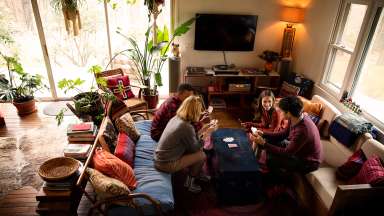Jump To:
What is Co-living?
Co-living is a relatively recent term which describes a shared living arrangement amongst a group of individuals. While the term may be new, the concept of shared, communal living is not. Historically, these arrangements have been known by many different names and have taken on a variety of forms (Boarding Houses, Single Room Occupancies, Communal living, etc.). Generally they offer individuals who are unrelated a private living space. Also access to a communal kitchen, bathrooms, and living area(s). The square footage of individual rooms is generally smaller than a typical studio apartment. Units are typically rented, offering flexible short- or long-term stays.
In essence, a co-living arrangement allows four or more unrelated persons the ability to cohabitate together. They can rent private rooms within a building while sharing amenity spaces amongst the occupants of the building. No more than two individuals may occupy private rooms (i.e. sleeping units). These rooms may contain either bathroom or kitchen facilities, but not both.
Benefits of Co-living
Co-living rental prices are typically more affordable than standard apartment units. This is due to shared common spaces, and smaller private spaces. In addition, by expanding where this use can operate, it could help create more housing opportunities in high-demand areas of the city.
Existing Regulations
Today, the closest defined use we have to ‘Co-living’ is the ‘Boardinghouse’ use as defined in UDO Sec. 6.2.2.B. The Boardinghouse use is defined as “a facility that contains individual rooms that are rented to the general public to more than 4 unrelated persons for periods in excess of 30 days, and which includes a rooming house.” The Boardinghouse use contains the following use standards:
- The facility was constructed originally as a detached house.
- The total number of individuals occupying a boardinghouse is limited to 6
- In a Residential District, there is no exterior advertising except 1 unlit announcement sign not to exceed 2 square feet in area.
- No boardinghouse can be located within 1,200 feet of another boardinghouse (determined by a straight line from property line to property line).
- The minimum tenant rental period exceeds 30 days.
- Cooking facilities shall not be permitted in the rented rooms of the boarding house.
- The facility shall comply with the City’s Housing Code, Article 11.6 of this UDO.
Currently the Boardinghouse use is allowed as a ‘Special Use’ within the R-10 zoning district. It is not permitted within any other Residential zoning district. ‘Special Uses’ (S) may be appropriate in a particular zoning district. Because of the increased potential for incompatibility with adjacent uses, it requires individual review by the Board of Adjustment. ‘Limited Uses’ (L), are uses that are permitted in a particular zoning district and subject to the objective use standards as set forth in the UDO. The Boardinghouse use is allowed as a Limited use within the following Mixed-Use Districts: RX-, OX-, NX-, CX-, and DX- (see Table 1).
Proposed Changes
This text change proposes to rename the existing Boardinghouse use to ‘Co-living’. It also updates some of the existing use standards. However, there will be no change to the specific standards that regulate this use within Residential zoning districts.
Under this proposal, a co-living use located within a residential zoning district will be held to the same standards as what currently applies for Boardinghouses (no change):
- The facility was constructed originally as a detached house for single-unit living.
- The maximum number of individuals occupying the building is limited to 6.
- There can be no exterior advertising except 1 unlit announcement sign not to exceed 2 square feet in area.
- No co-living use can be located within 1,200 feet of another co-living use (determined by a straight line from property line to property line).
This proposed text change would revise the regulation of how the use is regulated by allowing co-living within the IX- mixed-use zoning district. The text change also proposes to allow co-living uses to be located within an apartment or mixed-use building. Co-living must be located in the following MU districts (RX-, OX-, NX-, CX-, DX-, IX-). The uses must also provide a minimum of 250 square feet of gross floor area per one-person sleeping unit and 500 square feet of gross floor area per two-person sleeping unit.
Table 1- Boardinghouse/Co-living Use Table from Sec. 6.1.4. Allowed Principal Use Table of the UDO.
Special Use (S), Limited Use (L)
| RESIDENTIAL DISTRICTS | |
|---|---|
| R-1 | -- |
| R-2 | -- |
| R-4 | -- |
| R-6 | -- |
| R-10 | S |
| MIXED USE DISTRICTS | |
|---|---|
| RX- | L |
| OP- | -- |
| OX- | L |
| NX- | L |
| CX- | L |
| DX- | L |
| IX- | L - Proposed Change |
